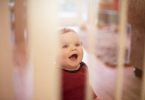50% of babies wake at least once in the night and 35% of parents claim to be affected by sleep deprivation. Is it any wonder that parents turn to baby sleep training? A good night’s sleep means a happier and healthier child — and a rested parent. So where do you start? This article looks at when sleep training can start, how to structure your day and bedtime routine to maximize your chances of success and the four most common methods of sleep training.
When to Start Sleep Training a Baby
Sleep training can begin when most babies are between four and six months old. At four months, babies have started to develop specific sleep patterns and also require less late night feedings. However, not all babies will be emotionally ready for sleep training so if your baby won’t sleep at night, no matter what sleep training method you have tried, it is advised that you consult your paediatrician to determine if your baby is developmentally ready to undergo a set baby sleep training program. Babies develop at varying emotional and mental rates and some babies may need longer to adjust before embarking on a coordinated sleep training method.
Sleep Training Tips
Just like adults, babies benefit from a little preparation and the right circumstances to help make them more receptive to sleep. Whichever sleep training method you choose, you will need to follow a few steps to make sure your baby is relaxed and not over-tired to increase your chances of success. Here are a few basic pointers to prepare for sleep training your baby.
Create a Bedtime Routine
Babies thrive on routine – especially at bedtime. A predictable bedtime routine will help to relax them and get them ready for sleep. A bedtime routine should start at the same time each night, and could be followed by a warm bath, a lullaby, bedtime stories or gentle rocking.
Daytime Routine
Your baby’s daytime routine can also influence how well he sleeps at night. Getting your little one up at a regular time each morning and putting him down for designated naps all help build a sleep schedule that will overflow into his nighttime cycle.
Sleep Environment
Nightlights, soothing crib mobiles, and lullaby music that is monotone, are all sleep aids that can create an environment that is conducive to a restful slumber. The bedroom should also be an ideal temperature so that the baby is not too hot or too cold. Most experts agree that a room temperature of around 70 degrees F. with a relative humidity ratio of 50 percent is optimum for a restful night’s sleep. (More on how to create a safe and comfortable sleep environment here.)
Well-Known Baby Sleep Training Methods
Many parents opt to follow one of the well-known baby sleep training methods that are advocated by experts. However, all parents should remember that just because one expert’s sleep training program worked well for their baby does not mean that your baby will respond favorably. All babies are different so research the various methods and don’t be afraid to change or modify the method to fit your infant’s specific needs. After all — no one knows your child better than you.
Ferber Sleep Training Method
Founder and former director of the Center for Pediatric Sleep Disorders at Children’s Hospital in Boston, Pediatrician Richard Ferber first published his revolutionary baby sleep training book, ‘Solve Your Child’s Sleep Problems,’ in 1985. His sleep training methods have come to be known as “Ferberizing” the infant with a “cry it out” approach. The sleep training method focuses on allowing the baby to learn to self-sooth and simply cry until he falls asleep. However, Ferber is quick to recommend that the infant should not be left completely unattended to simply cry for long stretches of time. He does encourage parents to step in and offer some form of comfort during the child’s adaptation stage when the infant continues to cry.
Advocates of the ‘Ferberizing sleep training method’ are very supportive, however, many others feel that allowing an infant to cry leaves long-term emotional scars on the child and may create lifelong phobias and feelings/fears of abandonment. Many infants respond to the Ferber sleep training method in a few days or a week, but others never truly respond and continue to cry if left unattended. Ideally, the Ferber sleep training method should take around seven days before the baby is falling asleep independently, without crying.
Dr Ferber’s method has attracted a lot of controversy from parents and psychologists over the years, but a recent study by Flinders University suggests that babies suffer no adverse affects as a result of crying it out.
Dr. Sears Sleep Training Method
An American paediatrician and co-author of over 30 parenting books, Dr. William Sears is well known for his gentle approach to infant sleep training. His sleep training method focuses on modifying the environment around the infant to create a soothing and comforting space where the baby can fall asleep safely and soundly. He believes that sleeping should never be a fearful event for the baby. Dr. Sears advocates that all babies are different and have varying sleep needs. Some infants sleep best alone in a crib and others crave a restful sleep snuggled in their parents’ bed.
No matter where the baby sleeps best, Dr. Sears sleep training method focuses on never leaving the baby alone to cry or become overly upset. Someone is always with the baby as he drifts off to sleep in order to foster a secure feeling.
Unlike other sleep training methods, Dr. Sears advises that a parent should comfort an infant immediately when it cries.
He suggests that each parent should try a variety of approaches to comfort their infant and lull them to sleep. The moment the baby starts to whimper or cry the parent should immediately respond to the baby and provide some form of soothing reassurance. The reassurance helps the baby relax and ultimately fall asleep. Providing unlimited reassurance fosters feelings of love and security which helps an infant grow into a self-assured child and adult without fears of abandonment or deep-seated phobias.
There are a variety of soothing approaches that a parent can use if their child starts to fuss or wakes up crying at night. These soothing techniques include:
- Bottle feeding (a newborn needs to be fed; a one-year-old probably doesn’t)
- Sucking on a pacifier or thumb
- Gentle tummy-patting
- Singing a lullaby in a soothing voice
- Rocking the baby
- Snuggling beside the baby
- Offering verbal reassurance
Super sensitive infants may require additional reassurance before they fall into a sleep training routine. Such babies often need extreme quiet to sleep peacefully and even small noises may disturb or wake the baby. Light is another factor that might make sleep training difficult if your baby is hypersensitive to external stimuli. Often making sure the room is completely dark or having a nightlight is all that a troubled infant requires to settle down and fall asleep soundly. Sleepwear is another issue that might upset super sensitive infants. If the sleepwear is not comfortable, is scratching, or too tight, the infant might fight falling asleep or wake up throughout the night. Tummy trouble and teething pains are other factors that may make sleep training difficult or impossible until the infant is older.
Fading Sleep Training Method
The Fading Sleep Training Method is considered to be a gentler sleep training approach than the Ferber Method of letting the baby cry it out. Ideally, the parent lessens their involvement each night in the child’s sleep routine so the baby adjusts gradually to the parent not being present in the room. Often the parent will sit with the infant as he falls asleep and occasionally touch the baby and soothe. Then the parent would reduce the physical soothing and move further away from the baby’s crib until eventually the parent leaves the room. With the Fading Sleep Training Method the parent can also set an alarm and check on the baby at intervals of five or ten minutes instead of remaining in the room the entire time.
Pick Up/Put Down (PU/PD) Method
The PUPD sleep training method involves first trying to soothe the crying infant with a pat or a loving touch. If the baby continues to cry then you pick him up and once the baby stops crying, immediately place him back into the crib. The parent continues to touch the sleeping infant, but if the baby wakes again and starts to cry the parent must pick the baby up until he falls back asleep. After a few nights of using the PUPD method, it is time to start reducing the amount of touching and soothing so the the baby does not start to need constant hand contact to remain asleep.
Parents should always remember that all babies are distinct individuals and no method works perfectly for every baby. Even siblings or twins differ in their sleep needs. Sleep training a baby is a hit and miss experience but one that requires perseverance and a consistent approach. Every parent must experiment before they can determine how their baby will ultimately respond.





